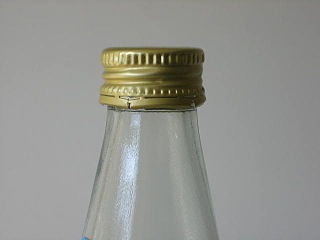
Cork is an impermeable buoyant material. It is the phellem layer of bark tissue which is harvested for commercial use primarily from Quercus suber, which is native to southwest Europe and northwest Africa. Cork is composed of suberin, a hydrophobic substance. Because of its impermeable, buoyant, elastic, and fire retardant properties, it is used in a variety of products, the most common of which is wine stoppers.
A screw cap or closure is a common type of closure for bottles, jars, and tubes.

A wine bottle is a bottle, generally a glass bottle, that is used for holding wine. Some wines are fermented in the bottle while others are bottled only after fermentation. Recently the bottle has become a standard unit of volume to describe sales in the wine industry, measuring 750 millilitres. Wine bottles are produced, however, in a variety of volumes and shapes.

A bottle cap or bottle top is a closure for the top opening of a bottle. A cap is sometimes colorfully decorated with the logo of the brand of contents. Plastic caps are used for plastic bottles, while metal with plastic backing is used for glass; plastic caps are commonly made from polyethylene or polypropylene, while metal caps are usually either steel or aluminum. Plastic caps may have a pour spout. Flip-Top caps like Flapper closures provide controlled dispensing of dry products. Caps for plastic bottles are often made of a different type of plastic from the bottle.

Red wine is a type of wine made from dark-colored grape varieties. The color of the wine can range from intense violet, typical of young wines, through to brick red for mature wines and brown for older red wines. The juice from most purple grapes is greenish-white, the red color coming from anthocyan pigments present in the skin of the grape. Much of the red wine production process involves extraction of color and flavor components from the grape skin.

A corkscrew is a tool for drawing corks from wine bottles and other household bottles that may be sealed with corks. In its traditional form, a corkscrew simply consists of a pointed metallic helix attached to a handle, which the user screws into the cork and pulls to extract it. Corkscrews are necessary because corks themselves, being small and smooth, are difficult to grip and remove, particularly when inserted fully into an inflexible glass bottle. More recent styles of corkscrew incorporate various systems of levers that further increase the amount of force that can be applied outwards upon the cork, making the extraction of difficult corks easier.

Bottling lines are production lines that fill a liquid product, often a beverage, into bottles on a large scale. Many prepared foods are also bottled, such as sauces, syrups, marinades, oils and vinegars.

A bottle opener is a device that enables the removal of metal bottle caps from glass bottles. More generally, it might be thought to include corkscrews used to remove cork or plastic stoppers from wine bottles.

Amcor plc is a global packaging company. It develops and produces flexible packaging, rigid containers, specialty cartons, closures and services for food, beverage, pharmaceutical, medical-device, home and personal-care, and other products.

A closure is a device used to close or seal a container such as a bottle, jug, jar, tube, or can. A closure may be a cap, cover, lid, plug, liner, or the like. The part of the container to which the closure is applied is called the finish.
The glossary of wine terms lists the definitions of many general terms used within the wine industry. For terms specific to viticulture, winemaking, grape varieties, and wine tasting, see the topic specific list in the "See also" section below.

Wine corks are a stopper used to seal wine bottles. They are typically made from cork, though synthetic materials can be used. Common alternative wine closures include screw caps and glass stoppers. 68 percent of all cork is produced for wine bottle stoppers.

Alternative wine closures are substitute closures used in the wine industry for sealing wine bottles in place of traditional cork closures. The emergence of these alternatives has grown in response to quality control efforts by winemakers to protect against "cork taint" caused by the presence of the chemical trichloroanisole (TCA).

Laroche Wines is a French-based wine company. The Laroche family has been producing wine in Chablis since 1850, but the first vintage did not come until 1860. In 1950s and 1960s, the vineyards were hit hard by Phylloxera and spring frost, meaning there were virtually no production. In the 2000s, the entire Laroche Wines Chablis range became fully enclosed by screw caps rather than corks, including the Chablis Grand Crus, becoming the first house in France to do so.

Closure is a term used in the wine industry to refer to a stopper, the object used to seal a bottle and avoid harmful contact between the wine and oxygen.

PlumpJack Winery is a boutique winery in Oakville, California, specializing in premium Cabernet Sauvignon wines. PlumpJack was the first winery in Napa Valley to use screwcaps as a wine closure on fine wines. The winery is one of several businesses operated by the PlumpJack Group. The name of the company is inspired by "the roguish spirit of Shakespeare's Sir John Falstaff, dubbed Plump Jack by Queen Elizabeth."

A tamper-evident band or security ring serves as a tamper resistant or tamper evident function to a screw cap, lid, or closure. The term tamper-proof is sometimes used but is considered a misnomer given that pilfering is still technically possible.
Pewsey Vale vineyard was founded in Eden Valley, South Australia during 1847 by Englishman, Joseph Gilbert. It is currently part of S.Smith and son. It was the first vineyard established in what is now the Eden Valley wine region and the first to plant Riesling vines in Australia. Pewsey Vale has become one of Australia’s leading producers of commercial riesling, with its signature wine being the Contours Riesling.
Grosset Wines is an Australian winery based in the Clare Valley wine region of South Australia.
Domaine Laroche is a family business winery in the Chablis AOC. The vineyards of Domaine Laroche are spread across Chablis, and are currently undergoing conversion to organic viticulture. Grégory Viennois, a graduate of the University of Burgundy, is the winemaker. Chablis AOC wines are produced exclusively from the Chardonnay grape. Domaine Laroche decided to bottle its offering under screw caps to keep wines fresh and prevent cork taint, but later switched back to using corks.
















